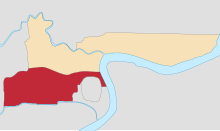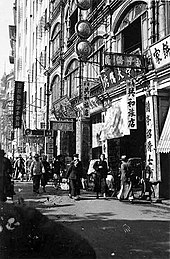Shanghai French Concession
This article needs additional citations for verification. (November 2015) |
| Shanghai French Concession Concession française de Changhaï 上海法租界 | |||||||||
|---|---|---|---|---|---|---|---|---|---|
| Foreign concession of Second French Republic, Second French Empire, French Third Republic and French State | |||||||||
| 1849–1943 | |||||||||
 Location of French Concession in Shanghai (red) relative to the International Settlement (yellow) and Chinese zone | |||||||||
| Population | |||||||||
• 1932 | 478,552 | ||||||||
| History | |||||||||
• Established | 1849 | ||||||||
• Disestablished | 1943 | ||||||||
| |||||||||
| Today part of | Huangpu District and Xuhui District, Shanghai Municipality | ||||||||
The Shanghai French Concession[a] was a foreign concession in Shanghai, China from 1849 until 1943, which progressively expanded in the late 19th and early 20th centuries. The concession came to an end in 1943, when Vichy France under German pressure signed it over to the pro-Japanese Reorganized National Government of China in Nanjing. For much of the 20th century, the area covered by the former French Concession remained the premier residential and retail district of Shanghai, and was also one of the centers of Catholicism in China. Despite re-development over the last few decades, the area retains a distinct character and is a popular tourist destination.
History[edit]

Establishment[edit]
The French Concession was established on 6 April 1849, when the French Consul in Shanghai, Charles de Montigny, obtained a proclamation from Lin Kouei (麟桂, Lin Gui), the Circuit Intendant (Tao-tai/Daotai, effectively governor) of Shanghai, which conceded certain territory for a French settlement. The extent of the French Concession at the time of establishment extended south to the Old City's moat, north to the Yangjingbang canal (Yang-king-pang, now Yan'an Road), west to the Temple of Guan Yu (Koan-ti-miao, 关帝庙) and the Zhujia Bridge (Tchou-kia-kiao, 褚家桥),[1] and east to the banks of the Huangpu River between the Guangdong-Chaozhou Union (Koang'tong-Tchao-tcheou kong-hoan) and the mouth of the Yangjingbang canal. The French Concession effectively occupied a narrow "collar" of land around the northern end of the Old City, south of the British settlement. At an area of 66 hectares (986 mu), the French Concession was about a third of the size of the British settlement at that time. A further small strip of riverside land to the east of the Old City was added in 1861, to allow the construction of the quai de France, to service shipping between China and France.
Demography[edit]


While the French Concession began as a settlement for the French, it soon attracted residents of various nationalities.
In the 1920s, with the expansion of the French Concession, British and American merchants who worked in the International Settlement often chose to build more spacious houses in the newer part of the French Concession. One legacy of this Anglophone presence is the American College on Avenue Pétain (now Hengshan Road), and the nearby Community Church.
Shanghai saw a large influx of Russian émigrés in the wake of the 1917 Russian Revolution. This raised the Russian population in the French Concession from 41 in 1915 to 7,000. This number increased to 8,260 by 1934 after the Japanese occupation of northeast China, where many Russians worked on the Chinese Eastern Railway. Two Russian Orthodox churches can still be seen in the former French Concession. The Russian community had a large presence on commercial streets such as Avenue Joffre and contributed to the development of the music profession in Shanghai.
The Chinese population in the French Concession swelled during the Taiping Rebellion, reaching about 500,000 just before the start of the Second Sino-Japanese War. During World War II, Japanese forces initially occupied only the Chinese areas, leaving the foreign concessions alone. Residents of the Chinese areas moved into the French Concession in large numbers, reaching 825,342.
Localities[edit]


- Lokawei (Chinese: 卢家湾; pinyin: Lújiāwān), "Lu's Bay", an area named after a bend on the Zhaojiabang creek. The main police depot and prison of the French concession was located here. Former Luwan District, today part of Huangpu District, was named after this locality. Since the 1990s, this area has seen high volume residential developments.
- Zikawei ("Xu's Confluence", or "Xujiahui" in Mandarin), an area named after the family of Xu Guangqi and the confluence of two local rivers. While Xujiahui was technically not part of the French Concession (lying immediately west of the boundary of the concession), it was the center of Catholic Shanghai, featuring St Ignatius Cathedral, the Observatory, the Library, and several colleges, all of which were French-dominated. Today, Xujiahui is a busy commercial district. Today's Xuhui District is named after this locality.
- Avenue Joffre, now Central Huaihai Road, was a boulevard stretching across the French Concession in an east–west direction. The road was renamed after Joseph Joffre in 1916, with the new name unveiled by the marshal himself in 1922. Avenue Joffre was a tram route. Its eastern section featured Shikumen residences. Its western part featured high-end residential developments, including standalone houses and apartment blocks. The central section was – and is – a popular shopping area, with many shops opened by the Russian community. The former Avenue Joffre remains a high-end retail district.
- Avenue Pétain, now Hengshan Road, was a major boulevard linking Xujiahui with the centre of the French Concession. It represented the centre of the French Concession's high-end residential district and featured many mansions and expensive apartment buildings. Beginning in the 1990s, some of the former houses had been converted into bars and nightclubs. Although some bars remain, recent years have seen the street become more residential.
Historical buildings in the French Concession[edit]
-
Former site of the International Mixed Court for the French Concession
-
Former Route Paul Brunat fire station
-
Former Avenue Joffre police station
-
Former Garde Municipale headquarters
-
Former residence of Sun Yat-sen
-
The Cloisters, a residential building
-
Grosvenor House, an apartment building, now part of a hotel
-
Lyceum Theatre, mainly used by British residents
-
Former Hôpital Sainte Marie
-
The Shanghai Science Hall, built in 1917, formerly a French school
-
1937 photograph of Japanese troops entering inside the French Concession
See also[edit]
- Concessions in China
- French colonial empire
- List of French possessions and colonies
- Old City of Shanghai
- Shanghai International Settlement
- American Concession in Shanghai
References[edit]
Notes[edit]
- ^ French: Concession française de Changhaï; Chinese: 上海法租界; pinyin: Shànghǎi Fǎ Zūjiè; Shanghainese pronunciation: Zånhae Fah Tsuka
Citations[edit]
- ^ The commonly recorded "诸家桥" appears to be an erroneous back-translation from a French source: 城区史首在史料准确--《上海卢湾城区史》若干史料问题商榷(许洪新) Archived 18 November 2013 at the Wayback Machine
Sources[edit]
- Le Paris de l'Orient – Présence française à Shanghai, 1849–1946, ministère des Affaires étrangères français.
Further reading[edit]
- Maybon, Ch. B (1929) Histoire de la Concession Française de Changhai, Paris: Librairie Plon
- Cady, J. F. (1942), "The Beginnings of French Imperialism in the Pacific Orient", Journal of Modern History, 14 (1): 71–87, doi:10.1086/236591, S2CID 143922413
- Willens, Lilane (2010). Stateless in Shanghai. China Economic Review Pub. (HK) Limited for Earnshaw Books. ISBN 9789881815484.
External links[edit]
- Xuhui District government portal Archived 10 October 2017 at the Wayback Machine
- States and territories established in 1849
- States and territories disestablished in 1943
- 1849 establishments in China
- 1849 establishments in the French colonial empire
- 1943 disestablishments
- 1943 disestablishments in China
- Concessions in China
- European colonisation in Asia
- French colonial architecture
- French colonial empire
- History of Shanghai
- Landmarks in Shanghai
- Tourist attractions in Shanghai
- Xuhui District













